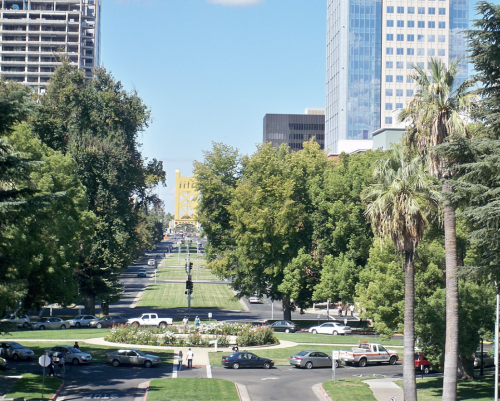

Environmentalists Can Build Nicer, More Valuable Cities Than The Sprawl We Build Now
(c) By Mark Dempsey
Special to The Vanguard
SACRAMENTO, CA – A recent discussion with an environmentalist friend reminded me that the current system formulating the public policy guiding city design is designed to fail, and works as designed. Cities are very profitable to build, but always not for the public.
I’ve said this before (in 1993), and Jane Jacobs, author of The Life and Death of the Great American City agrees: “The pseudoscience of planning seems almost neurotic in its determination to imitate empiric failure and ignore empiric success. [Sprawl planners] are all in the same stage of elaborately learned superstition as medical science was…when physicians put their faith in bloodletting.”
A recent Sacramento Bee report lamented people “stubbornly persisting” in buying gas, even at inflated prices. However, after decades of building a city requiring every significant trip be in an auto, one can hardly be surprised that people stubbornly persist in going to the grocery store, work, or school the only way possible–in a car.
Sprawl also sabotages any alternative to driving. Often no sidewalk connects the bus or tram stop to the neighborhood, and the neighborhood is not compact, so not enough customers for transit or neighborhood commerce are within a walk, even if they could walk to the stop. Disconnected sidewalks are common in sprawl.
In sprawl, autos dominate streets, too. The quarter-circle at corners (the “curb radius”) is gigantic, ensuring pedestrians have a long way to go when they cross at the street corner, and cars don’t have to slow down to take the turn. It’s dangerous to be a pedestrian.
Sprawl also requires everyone of driving age own a car–one of the most regressive “taxes” in existence. Sprawl builds the walk out of neighborhoods, and the lack of exercise shows up in record rates of obesity, heart disease, and diabetes.
In sprawl, people too young or too old to drive are out of luck. Little Johnny often can’t even walk to the park, and rather than aging in place, grandma has to go to that lovely “warehouse” (retirement home) to make a whole new set of neighbors’ acquaintance.
What would good planning look like?
Pedestrian-friendly streets–Traditional neighborhoods have streets with set-back sidewalks, even on-street parking to shield pedestrians from fast-flowing traffic. The curb radius is small enough that cars have to slow down to turn. Lighting is on 10′ – 14′ poles (sprawl’s are much taller) and would be easy on the eyes. Take a walk after dark in sprawl if you want to see light appropriate for police interrogation.
Mixed-Income Neighborhoods–This means multifamily and single-family residences coexist. It also provides affordable housing and reminds the rich and poor that they live not behind locked gates, but in society together. Compact neighborhoods also provide enough customers for transit or neighborhood commerce and infrastructure that’s half as expensive to maintain.
Mixed-Use Neighborhoods–Mixing uses–residences, commerce, offices, even light industry–means that pedestrians can walk to useful destinations. It also means transit can provide multiple destinations for those who want to shop or work. This can occur at very low densities (as around McKinley Park in Sacramento), or even in a metropolis–Union Square in San Francisco has multi-story residences, offices, and commerce in one compact area.
You may hear builders are simply supplying what people want in sprawl, but if that were true, then buyers would pay more to live there. Exactly the opposite is true. People pay premiums to live in pedestrian-friendly neighborhoods. Per square foot, the most valuable real estate in the region is around McKinley Park.
Unsurprisingly, people drive less in those “traditional” neighborhoods. Reductions in vehicle miles traveled (VMT) average half of what one might expect in sprawl. People could actually, as they do in San Francisco, have no car!
The good news is that the State of California has mandated pedestrian-friendly (“Complete”) streets, and reductions of VMT be part of any new development’s design. The bad news, according to my environmentalist friend, is that developers are saying they comply with these requirements when they clearly do not. It may take a lawsuit to wake them up…. We’ll see.
(Freelance writer Mark Dempsey sat on a Sacramento County Planning Advisory Council for nearly a decade.)
